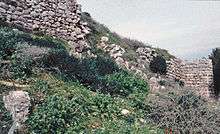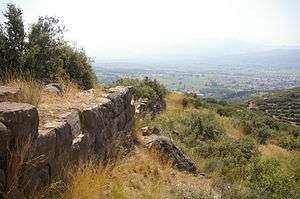Swedish Institute at Athens
The Swedish Institute at Athens (Swedish: Svenska Institutet I Athen; Greek: Σουηδικό Ινστιτούτο Αθηνών) is one of the 19 foreign archaeological institutes operating in Athens, Greece. It is one of three Swedish Mediterranean Institutes along with the Swedish Institute in Rome and the Swedish Institute in Istanbul.

General information, facilities
Established in 1948, the Swedish Institute at Athens was the 7th foreign archaeological institute to be founded in Greece, and the first since World War I. Throughout its history it has developed an important record of fieldwork at various locations in Greece. The Swedish Institute at Athens is organized as a private foundation mainly funded by the Swedish Ministry of Education, but also by contributions from various foundations for specific projects, conferences and fieldworks. Since 1974 the institute is located at the corner of Mitseon and Kavalloti close to New Acropolis Museum, the Acropolis itself and a number of other important historical sites.
The statutes of the Institute gives the framework within which it must function: it is the scope of the Institute to further research into the culture of ancient Greece, to further education in the field in order to enrich our own culture and to stimulate and support the cultural exchange between Sweden and Greece. As such the Institute functions as the base for Swedish research and education in the field of Classical studies and Archaeology in Greece. The Institute offers courses for undergraduate and graduate students and provides resources for scholarly research and work. It also maintains the relation with the other foreign archaeological institutes in Athens, Greece and around the Mediterranean as a whole.
Among its many partners the Institute is working in particular close cooperation with the other Swedish Mediterranean Institutes in Rome and Istanbul. It also has a close relationship to the other Nordic Institutes in Athens (The Danish, Finnish and Norwegian institutes), together with whom it founded the Nordic library in Athens in 1995. Today this research library contains ca 50 000 volumes and 450 journals.[1]
Beyond research into the classical world The Swedish Institute at Athens also initiates and participates in a range of other activities connected to art and culture. These activities include, among others, art and literature with interdisciplinary projects, poetry readings and language exchanges, in particular between Swedish and Greek.[2] The institute also hosts and engages in lectures and seminars addressing various issues and challenges in society.
In 2014, the Swedish Mediterranean Institutes were threatened to be closed by the Swedish Ministry of Education declaring that the financial support would subside and eventually be terminated. However, after strong protests the proposition was revoked.
History of the institute
Although Swedish archaeologists have been active in Greece since the late 19th century, with the first excavations executed at the Sanctuary of Poseidon on Kalaureia in 1894, the Swedish Institute was not founded until 1948.[3] The reason why an institute had not been established previously went back to the early 1920s when Sweden was preparing its first Mediterranean institute. The choice stood between Rome and Athens, and the decision landed on Rome since it was deemed that an institute there would be more avantageous.[4][5] Consequently, the second institute, in Athens, took considerably longer to establish. Before it was even created more Swedish excavations were taking place in Greece. The permits for these were applied for through already established foreign archaeological schools in Athens.[6] One of the most important Swedish excavations in Greece predating the Institute took place at Asine during the early 1920s, executed as a joint French-Swedish undertaking.[7] Later it became a wholly Swedish excavation where, among others, the Swedish crown prince Gustaf Adolf took part.[8] After the inauguration of the Swedish Institute at Athens in 1948, the Institute was not allowed to perform fieldwork in its own name. This, however, changed after the fall of the regime of colonels in 1975.[9] Since then, the Institute has earned full status as an Archaeological School and conducted numerous excavations and surveys at many different locations in Greece, including the excavations at the Bronze Age settlement at Midea, the Berbati survey and the recent work at the Sanctuary of Poseidon at Kalaureia.
Archaeological work
The institute has performed fieldwork at a large number of sites in Greece. Currently the Institute conducts excavations at the Sanctuary of Poseidon at Kalaureia (Poros) in the Saronic Gulf, various forms of work at the ancient city of Hermione at the tip of the Argolid Peninsula and explorations at Vlochos in (Thessaly).

Former archaeological projects conducted by the Swedish Institute include excavations at Aphidna (Attica), Asine (Argolis), Agios Elias (Arcadia), Berbati (Argolis), Chania Kastelli (Crete), Dendra (Argolis), Malthi (Messenia), Midea (Argolis), Paradeisos (Western Thrace), and surveys at Asea (Arcadia), and Makrakomi (Phthiotis).
The sanctuary of Poseidon on Kalaureia (1894 and 1997–until present)
The excavations at the sanctuary of Poseidon at Kalaureia constitutes the oldest Swedish archaeological work in Greece with the first excavation taking place in 1894, executed by Sam Wide and Lennart Kjellberg.[10] Wide initiated the expedition and collected enough funding to secure the operation. Kalaureia was one of several choices that had been suggested to Wide and Kjellberg by German archaeologist Wilhelm Dörpfeld, who acted as a “general staff commander’ and advisor in practical matters.[11][12] The first visit to the site was made in Dörpfelds company in April 1894 when Wide and Kjellberg participated in one of his annual excursions. It was during this visit the decision was made by Wide to excavate the Sanctuary of Poseidon. At this point little of the site was uncovered and few remains of the sanctuary were visible.[13] The excavation that ensued began on 11 June 1894 and lasted until 13 August. Efforts were in particularly made on uncovering the architecture of the sanctuary. Finds that were made included among other things bronze statuettes and swords.[14] The results that the excavation had yielded was published in 1895.[15] No further archaeological work took place in the sanctuary until 1997. Since then, two major projects have been exploring the site: Fysisk miljö och dagligt liv i Poseidons helgedom på Kalaureia (2003–2005) under Berit Wells, and the Kalaureia Research Program: The Sea, the City and the God (2007–2012) under Berit Wells and then Arto Penttinen after the untimely death of the former. After 2012 limited fieldwork has taken place on a yearly basis with the most recent overarching effort from 2015. The objective of the work has been to investigate and study the relationship between the sanctuary of Poseidon and the ancient city of Kalaureia.
Hermione, Argolida (2015 – present)
The project in Hermione is a cooperation between The Ephorate of Antiquities in Argolida and the Swedish Institute at Athens. The general director of the project is Dr Alcestis Papadimitriou, Ephorate of Antiquities in Argolida and Dr Jenny Wallensten who is responsible for the Swedish team. The study aims to give a better understanding of the social life in a Greek polis from archaic to imperial times. This has been achieved through studying the built environments, family and other social structures and religious practices, including funerary rituals. In particular, the project has aimed to develop and use a range of digital methods to uncover the structure of the ancient city without extensive and time-consuming excavations.
Vlochos, Thessaly (2015 – present)
The archaeological project in Vlochos (Thessaly) is a collaboration between the Swedish Institute and the Ephorate of antiquities of Karditsa. The project is directed by Dr Maria Vaïopoulou, the director of the ephorate and professor Helene Whittaker at the University of Gothenburg. The focus of the project concerns the site of Strongilvoúni with remains of fortifications from Archaic to Hellenistic periods. In 2016 news about the site were widely circulated in media.[16] Although the results of the geophysical survey are most impressive, the way the work was presented by the media were misleading.
Kavala
The Institute also owns a Bauhaus mansion at Kavala. The house was originally built as a residence for staff of the Swedish Tobacco Monopoly since Kavala was an important city for tobacco trade in the beginning of the 20th century. Employees of the Tobacco monopoly sometimes had to stay there for many months at a time which created the need for a permanent residence.[17] The company bought the property where the house was built in 1934 and the construction of the house was finished in 1936. Swedish architect Emil Lindquist was hired and made preliminary drafts of the new house. However, the final drafts were made by Greek architect Panagiotis Manouilidis and differed a lot from Lindquists. Manouilidis had studied blueprints of modern Swedish building projects at the time which took its inspiration from the Germen Bauhausschool. This resulted in what was the most modern expression of that time with a plain and bright façade as well as a flat roof and a practical indoor design.
After WWII Kavala had started to become less important in the tobacco industry and in Greece its position had been assumed by Thessaloniki. The new director of the Swedish Tobacco Monopoly Olof Söderström, who had a keen interest in culture, therefore decided in 1963 to make the house in Kavala into a guesthouse for Swedish artists and scientists. In 1973 the Tobacco Monopoly started to investigate if it would be possible to sell the house. It was at this stage the idea to instead donate the house to the Swedish Institute at Athens took shape. This became a protracted process but eventually because of dedicated work from several people, among those Sweden's then ambassador Agda Rössel and the Swedish Institute's director Pontus Hellström, the final negotiations were signed on June 9, 1976 at the Swedish embassy.[18] Today, the Swedish House in Kavala keeps welcoming scientists and artists alike with many having witnessed to its stimulating and inspiring environment.
List of directors
- Erik Holmberg 1947–1948
- Åke Åkerström 1948–1956
- Arne Furumark 1956–1957
- Paul Åström 1958–1963
- Carl-Gustaf Styrenius 1963–1971
- Åke Åkerström 1971–1972
- Pontus Hellström 1972–1976
- Robin Hägg 1976–1994
- Berit Wells 1994–2003
- Ann-Louise Schallin 2004-2010
- Arto Penttinen 2010-2016
- Jenny Wallensten 2017-
See also
Bibliography
- E. Korka et al. (eds.): Foreign Archaeological Schools in Greece, 160 Years, Athens, Hellenic Ministry of Culture, 2006, p. 144–151.
References
- Hellenica. 154: 3. Missing or empty
|title=(help) - Hellenica. 154: 3. Missing or empty
|title=(help) - Whitling. Western Ways. Foreign Schools in Rome and Athens. p. 150. ISBN 978-3-11-060253-1.
- Wells & Pettinen. On Site Swedish Archaeologists in Greece. p. 35.
- Whitling. Western Ways. Foreign Schools in Rome and Athens. p. 91. ISBN 978-3-11-060253-1.
- Wells & Pettinen. On Site Swedish Archaeologists in Greece. p. 21, 22.
- Whitling. Western Ways. Foreign Schools in Rome and Athens. pp. 83–84. ISBN 978-3-11-060253-1.
- Wells & Pettinen. On Site Swedish Archaeologists in Greece. p. 23.
- Whitling. Western Ways. Foreign Schools in Rome and Athens. p. 192. ISBN 978-3-11-060253-1.
- Wells & Pettinen. On Site Swedish Archaeologists in Greece. p. 7, 19.
- Wells & Pettinen. On Site Swedish Archaeologists in Greece. p. 7, 19.
- Berg. Kalaureia 1894:A Cultural History of the First Swedish Excavation in Greece. pp. 74–75. ISBN 978-91-7649-467-7.
- Berg. Kalaureia 1894:A Cultural History of the First Swedish Excavation in Greece. p. 84. ISBN 978-91-7649-467-7.
- Berg. Kalaureia 1894:A Cultural History of the First Swedish Excavation in Greece. pp. 91–93. ISBN 978-91-7649-467-7.
- Berg. Kalaureia 1894:A Cultural History of the First Swedish Excavation in Greece. p. 104. ISBN 978-91-7649-467-7.
- https://www.independent.co.uk/news/science/archaeology/greece-lost-city-vlochos-university-of-gothenburg-bournemouth-a7471246.html. Missing or empty
|title=(help) - Gullberg Kaidi, K.; Penttinen, A. "Svenska Huset i Kavalla". Kontorousis. 28: 16.
- Gullberg Kaidi, K.; Penttinen, A. "Svenska Huset i Kavalla". Kontorousis. 28: 18.